A rapid glance at the flickering colors and fast black gestures of the labyrinthine Subway Series by the front window of the Quogue Gallery was all it took to confirm for me that the exhibition, “Harry Bertschmann,” would offer many rewards.
This show represents another superb rediscovery of a paint-slinger from New York’s heyday as the capital of Abstract Expressionism, in a space where viewers have happily encountered others from the era. With their brisk, jazzy energy and fearless handling of the paint, the first paintings I saw had all the trademark qualities of that movement: a little bit of de Kooning and Gorky, with some of the jumpy restlessness of Art Brut mixed in.
.
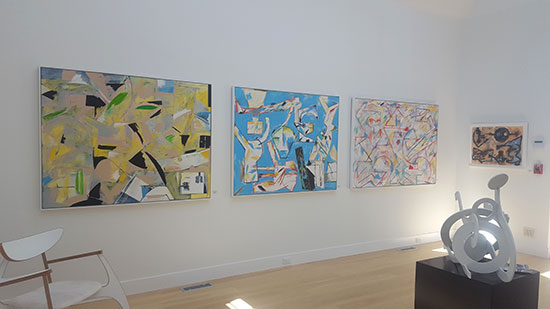
"Harry Bertschmann" at Quogue Gallery. Courtesy of Quogue Gallery.
.
As closely allied to New York Abstract Expressionist painting as the bold gestures and energetic hues seem to be, the artist’s backstory is as European as it is West Village; elements of both are woven together without committing the artist to one school or another. Bertschmann’s biography reads more like that of Paul Klee than Franz Kline. Born in Basel, he started his academic training there at the Kunstgewerbeschule (School of Design) in a rigorous four-year program, after which he was an apprentice at Fritz Buehler’s atelier. Buehler’s masterful Modernist posters and ads, prized by connoisseurs, offer some hints regarding Bertschmann’s approach to composition.
He kept his hand in packaging and logo design after emigrating to the United States in 1951. He lived in Cleveland, where in the 1950s he had no fewer than 10 solo shows at Case Western Reserve University and at the avant-garde Howard Wise Gallery, which moved to New York in the 1960s. The gallery gave him his first major break when in 1958 he was selected for the Carnegie International, where (at the tender age of 27) his paintings hung next to those of Mark Rothko, Franz Kline, Barnett Newman, Philip Guston and Robert Motherwell. That exposure gave Bertschmann’s career as a painter its needed boost. His work is now in such collections as the Boca Raton Museum and the Lila Wallace Reader’s Digest collection.
After an obligatory stint back home in the Swiss army, Bertschmann settled in Greenwich Village, where he and his wife started the Bank Street Press, which published poetry and children’s books that he designed. The highlight of the Quogue Gallery show is a group of works from the Bank Street series, painted from 1978 to 1985. I believe that every terrific painting exhibition has a knockout wall, and this show is no exception.
In the sunlit rear space that is the Quogue Gallery’s showcase for great color, a trio of large works with a blue beauty at its center riffs on some of the geometric themes of the Bank Street series, clearly one of the crucial groups of Bertschmann’s works. There is a rhythmic lightness to the formal vocabulary of the works that pairs well with the artist’s bright, Synchromist palette. The sky blue of the central work, Bank Street #39, is a stunning summer day brought down through the skylights to the wall. Across it prance a mask-like face and some geometrically stiffened limbs. To its left, a more abstract close harmony in vegetative greens and sandy or flesh-tinted forms, Bank Street #38, is punctuated by crisp black forms straight out of Miro, while to its right a more de Kooning-esque haze of pastel pinks and oranges, Bank Street #41, surrounds the angular shapes and swooping curves. This trio of superb, large paintings is reason enough to head to Quogue.
.
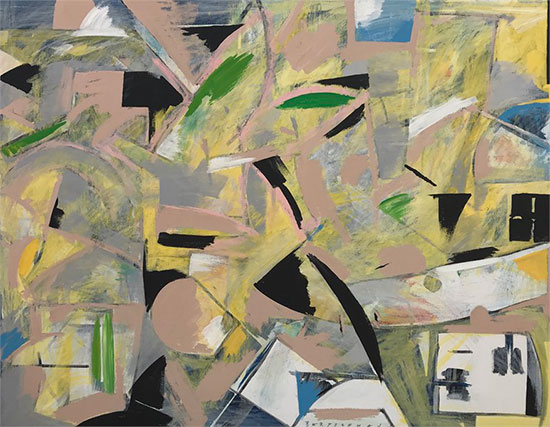
"Bank Street Series No. 38" by Harry Bertschmann,1978 - 1985. Acrylic on canvas, 48 x 63 inches. Courtesy of the Quogue Gallery.
.
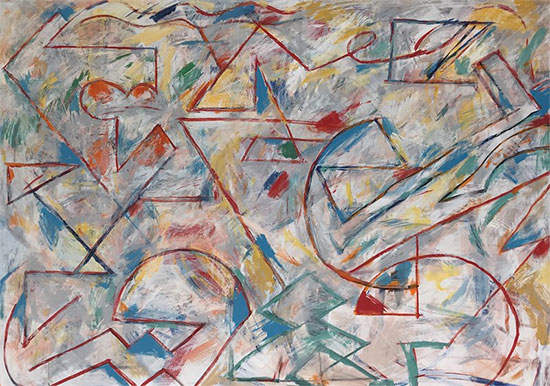
"Bank Street Series No. 41" by Harry Bertschmann, 1978 - 1985. Acrylic on canvas, 65 x 48 inches. Courtesy of the Quogue Gallery.
.
But there is much more. According to the eloquent essay by the eminent critic Robert Morgan that accompanies the show, whenever Bertschmann was in between series or ideas, he had a tendency, starting in 1970, to dash off quicker works he calls his haikus. Their improvisatory naturalness and their attractive colors add up to a terrific summer offering, refreshing in their proximity to drawings.
.
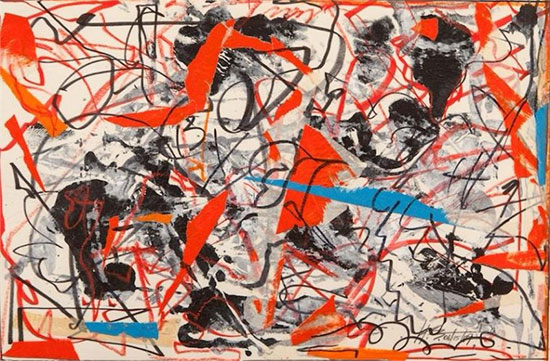
"Haiku Series No. 40" by Harry Bertschmann, 2009. China marker, acrylics on paper, 10 x 12 inches. Courtesy of The Quogue Gallery.
.
As Morgan so deftly observes, “The paintings resemble what the Chinese call ‘free script,’ that is, linear calligraphy that moves itself through time and space without effort. The temerity and tendril-like nuances of Bertschmann’s exquisite palimpsest exist on their own terms, in their own place. It persuades us without the slightest nodule of coercion. The form is at rest, yet pulsating with ideas.”
As a bridge between the Bank Street paintings and another significant series, Ab Ex Shapes, based on the formal language of Abstract Expressionism (also a major aspect of the Bank Street series iconography), the haikus are helpful documents pointing the newcomer toward the “heavier” material of the artist’s Figurative Series. These were represented in the show by a work that put a Fauve palette to work on a frieze-like procession of six highly kinetic figures, the most compelling of them in a bright blue.
.
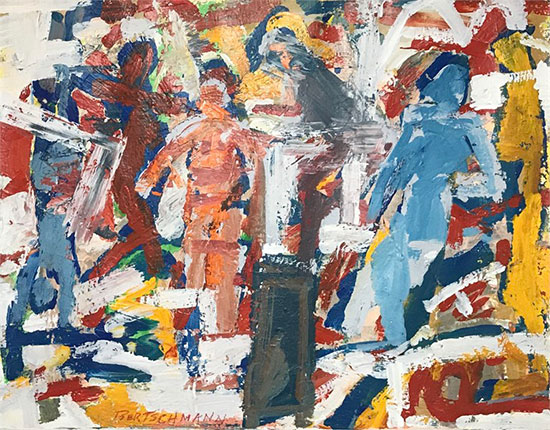
"Figurative Series No. 22" by Harry Bertschmann, 1970s. Acrylic on canvas, 25.87 x 31.75 inches. Courtesy of Quogue Gallery.
.
In his essay, Morgan tries to reconcile the two sides of Bertschmann: a highly trained graphic designer who is also a painter with obvious technical expertise. Visitors to the Quogue Gallery viewing the Figurative and Bank Street series might also wonder how Bertschmann’s drawings for a Bufferin ad and these action paintings are related, and what does that relationship suggest about the correlation between design and composition?
In my view, design is itself an easier aspect of the more challenging art of composition, which lends itself to what Mondrian and others have referred to, sometimes puzzlingly, as the “plastic” element of painting. When the forms (angled geometries, distant traces of still life or figure) of Abstract Expressionism are themselves abstracted by Bertschmann so that they appear in his works almost at a third remove from nature, the shapes are without doubt dependent on his sure eye as a designer. Still, the success of that trio of large and convincing paintings on one unforgettable wall attest to a higher sense of composition.
The Quogue Gallery show was my first encounter with the endlessly evolving Bertschmann, who becomes an even more fascinating artist when the viewer tries to unravel the effect on his work of his background in other media.
_______________________________
BASIC FACTS: “Harry Bertschmann” is on view from June 21 to July 19, 2018 at the Quogue Gallery, 44 Quogue Street, Quogue, NY 11959. www.quoguegallery.com
_______________________________
Copyright 2018 Hamptons Art Hub LLC. All rights reserved
